“The Vitruvian Man” by Da Vinci – The Famous Vitruvian Physique
The Vitruvian Man by Da Vinci was originally created around 1490 and it included annotations based on the works of Vitruvius, the renowned Roman architect. The image depicts the Vitruvian physique represented in two poses that are superimposed on top of each other, and Leonardo da Vinci’s ideal proportions for the human body are clearly illustrated. But why was the Vitruvian Man created in the first place, and what does the Vitruvian Man symbolism represent? Let us find out by taking a look at the Vitruvian Man meaning and significance.
Contents
Understanding The Vitruvian Man by Da Vinci
| Date Completed | c. 1490 |
| Medium | Ink on paper |
| Dimensions (cm) | 34 x 25 |
| Location | Gallerie dell’Accademia, Venice, Italy |
Leonardo da Vinci’s ideal human physique proportions are represented in the famous Vitruvian Man sketch. The writing above and below the circle and square is based on a passage in Book III of Vitruvius’ work De Architectura (20 – 30 BCE).
However, Leonardo da Vinci did not actually depict Vitruvius’ limb proportions in his Vitruvian Man measurements, but rather the ones he discovered from examining models in Milan.
While the design was titled after Vitruvius, several academics now doubt if such a title is suitable considering that it was first used back in the 1490s. But, before we learn any more about this famous drawing, let us take a little look at the man behind the artwork.
A Look at the Artist: Leonardo da Vinci (1452 – 1519)
| Nationality | Italian |
| Date of Birth | 15 April 1452 |
| Date of Death | 2 May 1519 |
| Place of Birth | Republic of Florence |
Leonardo da Vinci is often regarded as one of the finest artists in the history of art and is often acknowledged as the pioneer of the High Renaissance period. While having many missing paintings and less than 25 significant works ascribed to him, including several incomplete pieces, he painted some of the most important works in Western art.
His masterpiece, The Mona Lisa (1503), is often recognized as the most renowned artwork in the world.
His The Last Supper (1495) fresco is the most reprinted religious artwork of all time, and his Vitruvian Man sketch is widely considered a historical icon. He was respected for his technological brilliance, having invented flying aircraft, armored war vehicles, solar energy, a ratio generator, as well as the double hull. Since contemporary scientific techniques were in their infancy during the Renaissance, few of his concepts were produced or even possible during his lifetime.

A few of his lesser-known innovations, such as an automatic bobbin winder and a device for evaluating the tensile stress of wire, reached the manufacturing sector unnoticed. He produced significant advances in civil engineering, anatomy, hydrodynamics, optics, and geology, but he did not publish his results, and thus had little to no direct impact on later research.
Despite the absence of formal academic instruction, many scholars and researchers consider Leonardo da Vinci to be the prototypical “Renaissance Man,” a person of inquisitive nature and wildly innovative mind.
He is widely regarded as one of the most brilliant human beings ever to have lived. The depth and breadth of his pursuits were unprecedented in recorded human history, and his intellect and character appear to us superhuman, yet the person himself was enigmatic and aloof. Scholars acknowledge his worldview as scientific, even though the empirical techniques he employed were unconventional for that period.
The Vitruvian Man Meaning
As for the Vitruvian Man symbolism, the pieces’ proportions represent the universal design, as a “scientific” balance of components provides a sturdy construction. Therefore, God’s formation of the human physique and the human being’s own creation of structurally sound works share these attributes equally. This notion of the creative microcosm arose as one of the fundamental unifying elements of his philosophy in the late 1480s.
This structural applicability, nevertheless, is not the ending of the story; it is merely the start of a notion that has worldwide applicability.
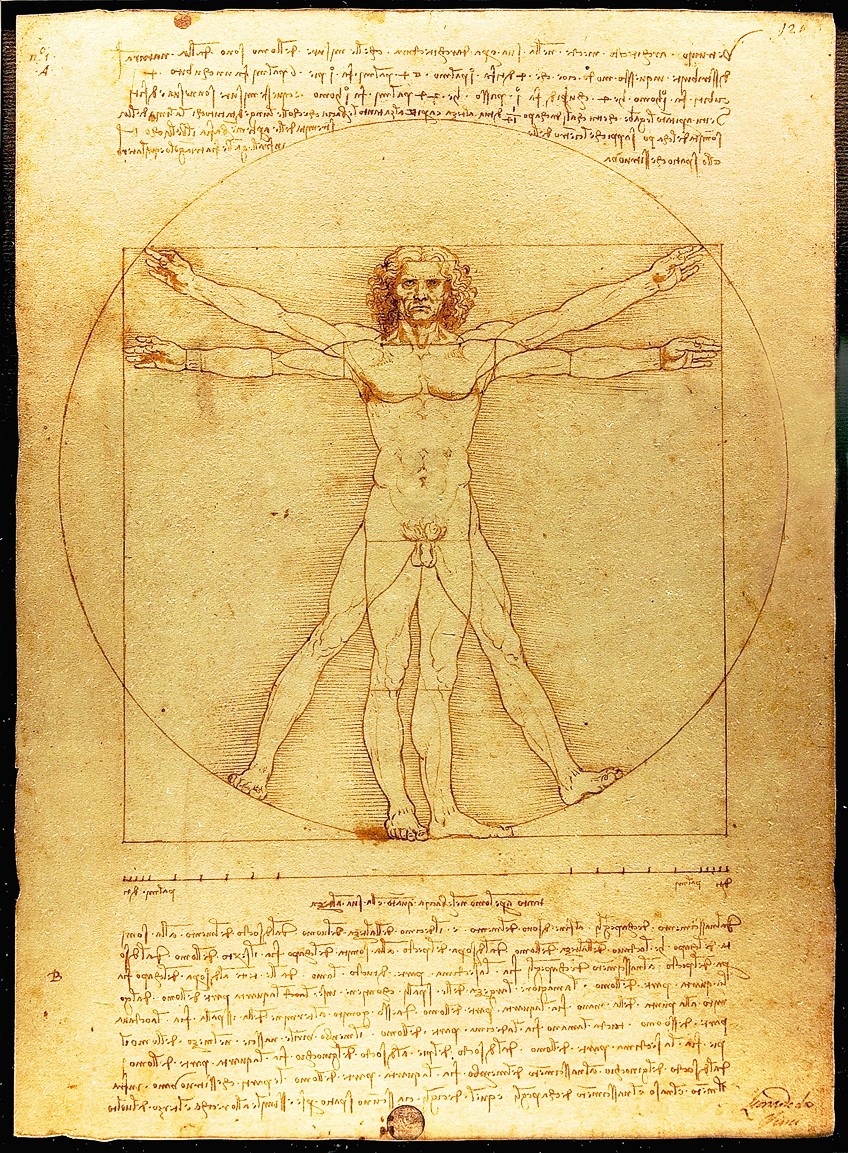
This artwork perfectly exemplifies Leonardo da Vinci’s intense focus on proportion. Furthermore, this painting is a cornerstone of his endeavors to connect man to nature. He envisioned the large pictorial chart of the human anatomy he had created through his figure drawings as a microcosmography.
He saw the functions of the human body as analogous to the functioning of the cosmos.
More Vitruvian Man Symbolism
Leonardo da Vinci was interested in discovering the ratios of all existence, not just man. The Vitruvian Man is a representation of his efforts to connect man to nature. The circle has long been associated with everything heavenly and celestial. It possesses the ideal form, with all of its extremities being equidistant from the middle.
The square represents the earth, all physical manifestations, and our position on the planet through the four elements, four seasons, and four directions. Humans were a mirror of the heavenly, existing within a circle.
Humans were a mirror of the Earth since they fit inside a square. Humans might create a bridge between the earthly and heavenly by symbolizing various components of the cosmos. Da Vinci connected the geometry of human anatomy to the geometry of the cosmos in a bid to uncover a connection between soul and substance, between Man and God, granting it an essentially worldwide significance.
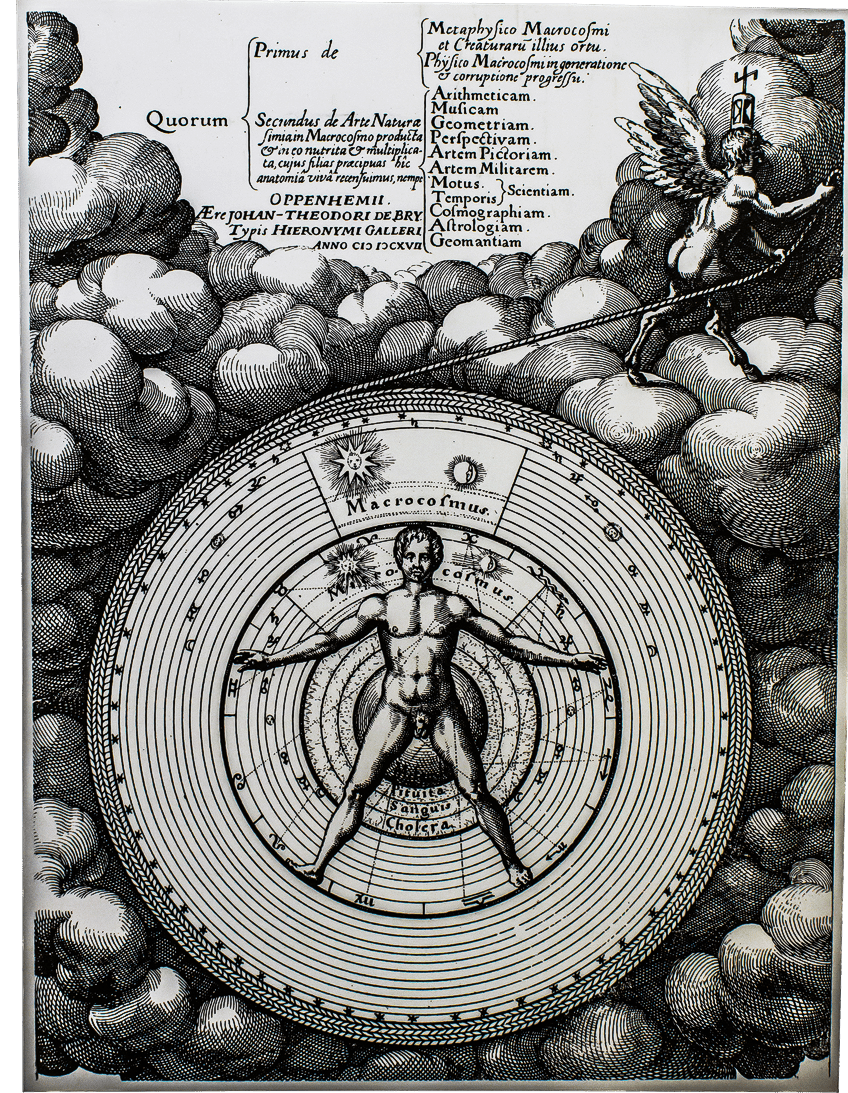
The human with innate geometric symmetry fills the world itself, aligns with it, and also creates one inside of himself. Da Vinci’s artwork has been used repeatedly throughout history to symbolize the Renaissance notion of man as a metaphorical microcosm, therefore celebrating his status as the core of the cosmos.
The Vitruvian Man, a wonderful illustration of Leonardo da Vinci’s inquisitive mind, continues to captivate painters, physicists, and intellectuals alike.
How Da Vinci Blended Math and Art
Da Vinci’s seemingly simple picture represents an effort to solve an age-old geometric puzzle. The annotations that accompany the artwork thoroughly clarify the important principles and meaning of the geometrical image. The artwork is also seen to be a theoretical answer to the existence of man and an allegory for how the cosmos works.
In regards to symmetry, weight, and proportion, Vitruvius thought that the rules regulating the portrayal of the physical figure also be applied to temple design.
He makes numerous assertions about human body ratios, such as the navel being the center point of the body, which could be utilized as a fixed location to create a perfect circle all around the figure, a man’s height is roughly equal to his arm length, and a drawing of a body with outstretched arms fitting flawlessly on the inside of a square.

Most of his colleagues failed to conceptualize this notion themselves. Da Vinci was equally captivated by the mathematical challenge of squaring a circle. Individually calculating the circumference of a circle or square was simple, but the true problem was creating a square that had the same size as a particular circle using a ruler and a compass.
Da Vinci was attracted by the concept that the shape of the human body is able to fit perfectly into both a square and a circle.
The Vitruvian Man Measurements and Geometry
Leonardo da Vinci, a master of art and science, produced a design that, different from those of all the other painters, was painstakingly created. The component that sets it apart from previous representations is that he split the centers of the two poses, one for the circle oriented at the navel and one for the square at the genital area.
This method is thought to have been proposed originally by Giacomo Andrea, Da Vinci’s close friend and Vitruvius scholar.
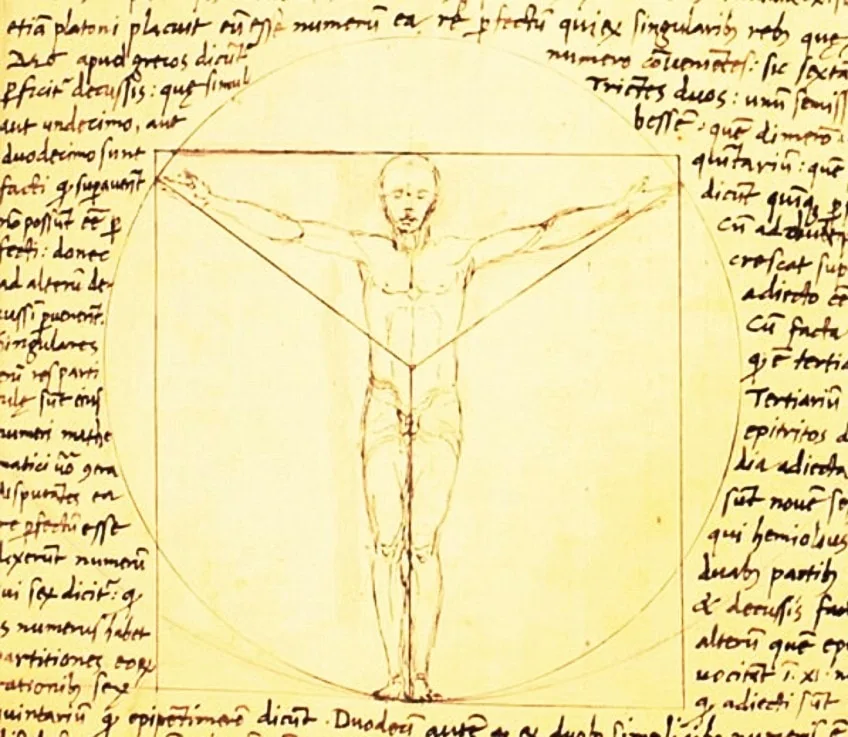
Although historians disagree on whether the duo collaborated, they believe Leonardo da Vinci rectified errors in a technique where Giacomo had faltered. The comments that accompany Da Vinci’s design clearly expand on Vitruvius’ classical building notions, as well as Da Vinci’s views on proportion and mathematics.
Captivated by the perfect proportions of the human body, he included the golden ratio notion in his designs.
Ownership of The Vitruvian Man by Da Vinci
Giuseppe Bossi obtained the artwork from Gaudenzio de’ Pagave and detailed, analyzed, and depicted it in his monographs. The next year, he extracted the portion of his book dealing with the Vitruvian Man and printed it, dedicating it to his acquaintance Antonio Canova. Following Bossi’s death in 1815, the Vitruvian Man was purchased by the Gallerie dell’Accademia in 1822. The Italia Nostra stated that the artwork was too delicate to travel after the Louvre wanted it for a significant display of Leonardo da Vinci’s works to start on October 24, 2019.
A court determined on October 16, 2019, that the group had not demonstrated that the art was too delicate to transport, although it did establish a maximum quantity of sunlight for the artwork to be subjected to, as well as a recovery period to counteract its total lighting exposure.
The original artwork is preserved in the Gallerie dell’Accademia in Venice, Italy, and is only sometimes displayed to the public, as are most artworks produced on paper from that period. Nowadays, the picture of the Vitruvian Man is seen as an emblem of physical fitness and health, and it is frequently used to depict a harmonious, fit man.
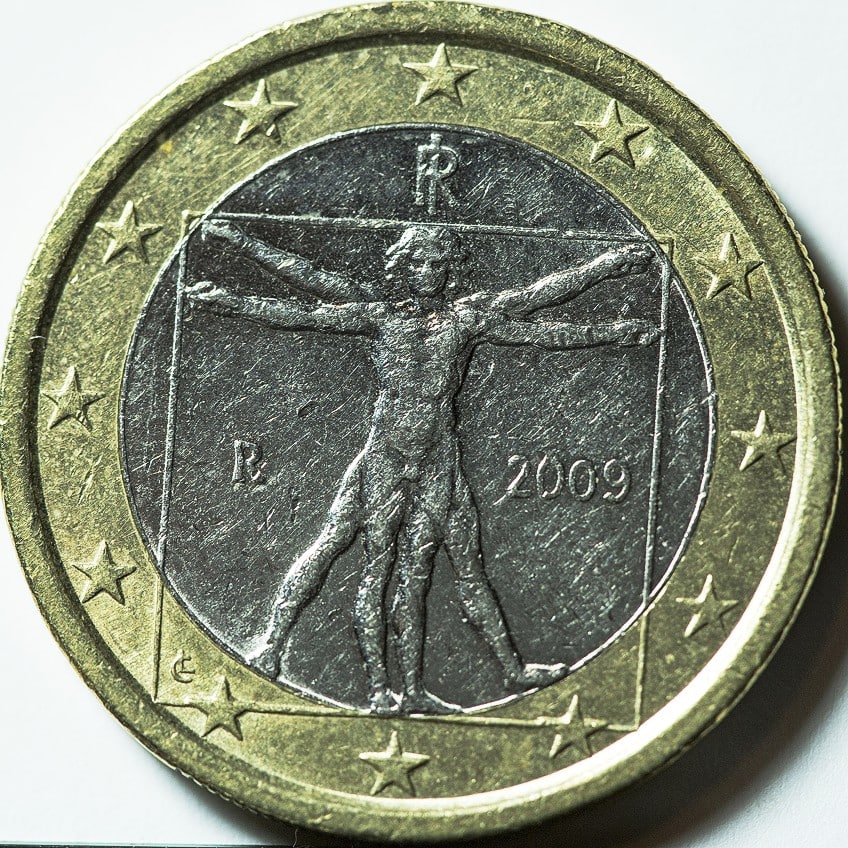
It is also affiliated with medicine, representing three fundamental characteristics of an ideal physician: knowledge, humanitarianism, and creativity. It was also engraved on the Italian 1 Euro coin, symbolizing money serving man rather than man serving money.
While it is unknown when the image will be made available to the public again, its exclusivity only adds to its attraction as a significant work in the history of both science and art.
Facts and Theories About the Vitruvian Man
Leonardo had no intention of displaying the Vitruvian Man. The drawing was uncovered in a personal journal of the High Renaissance artist. The work was purely for the artist’s personal use, and when he finished it about 1490, he probably had no idea it would ever be discovered or appreciated. A great number of artists began to try to portray that notion visually, particularly in the 15th century, and in the decades preceding Leonardo da Vinci’s own experience in art.
The identification of the model is unknown, although art historians believe Da Vinci used some artistic license in his depiction.
This piece was not so much a portrait as it was a meticulous picture of a flawless male figure produced by arithmetic rather than life. Based on sparse depictions of the 15th-century master as a young person, some art scholars think that Da Vinci is the basis for his Vitruvian Man. He was characterized as being very nicely proportioned, muscular, and attractive, with curly hair that fell to his shoulders.

Even though you can’t tell for certain that the character is Da Vinci himself, it is thought to be a self-portrait because people could imagine him staring at himself in that image and attempting to make meaning of the world. There is the image of Da Vinci as an intellectual with a long beard staring off into the horizon and exceeding his age.
However, in the 1470s, he was still very much coming of age; he was acquiring the skills of the profession, working as an assistant to other painters, making blunders, and enjoying himself.
Some speculate that Da Vinci was attempting to display God in the painting. There are many representations of world maps and cosmos maps with a square and circle then this human figure symbolizing — normally in the Christian perspective, Jesus — but also the type of paternal figure, God.
The Sources of Inspiration
Marcus Vitruvius Pollio was a Roman architect who flourished in the first century BC. He was a Renaissance engineer, architect, and author of the text De Architectura, which was the leading book about architecture at the time. All of the masters studied it and attempted to apply its teachings, particularly Leonardo da Vinci and Michelangelo. Around the year 15 BC, Marcus Vitruvius authored the De Architectura. He was most likely merely compiling the information of the time in one book; he is not thought to have “invented” all of those concepts.
The text was reproduced in Rome in 1486 by Fray Giovanni Sulpicio de Veroli and it experienced instant success, and all the masters began studying it.
We must keep in mind that throughout the Renaissance, builders, painters, and intellectuals were awestruck by the achievements of history that they had just recently begun to find, and Vitruvius’ book was the only extant document of ancient architecture. A beautiful structure, according to Vitruvius, should be symmetric and proportional.
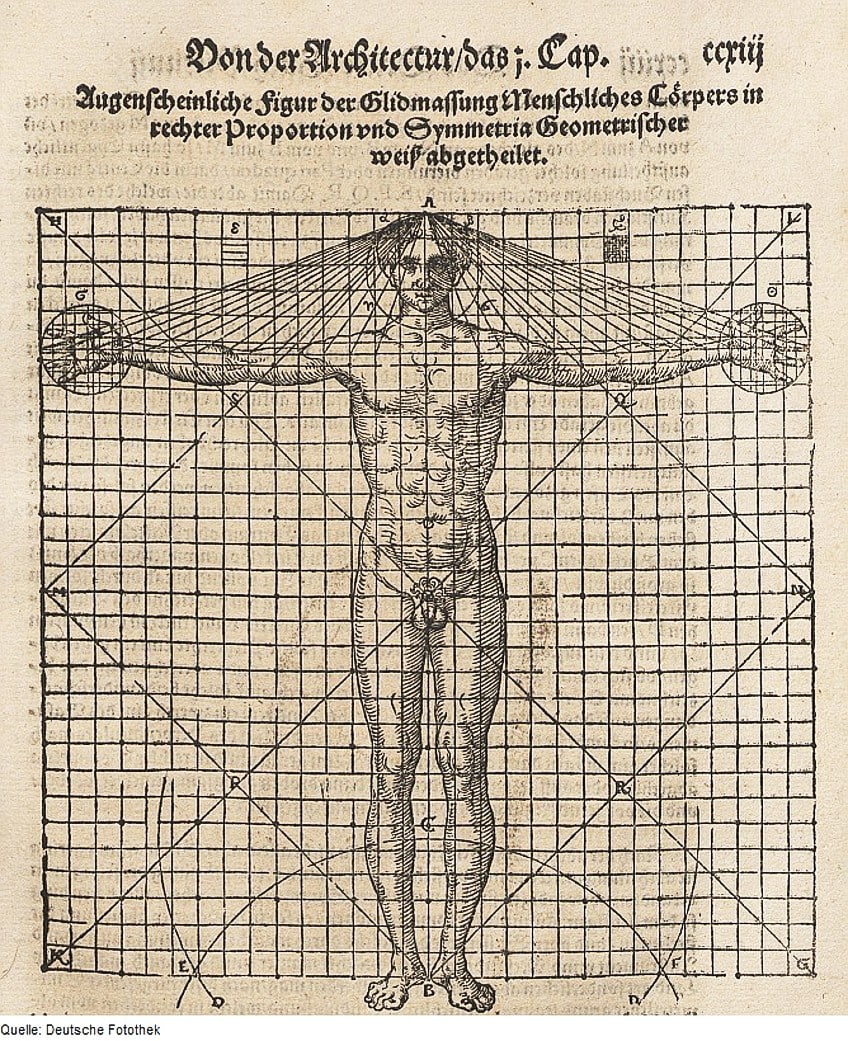
Both characteristics may be seen everywhere in nature, and no natural instance of harmony and proportion is more exquisite than the human body. So, the masters endeavored to depict a human form that corresponded to Vitruvius’ set of dimensions and was written in a square and circle. Leonardo da Vinci was neither the first nor the only person to work on this topic. The illustrations in Vitruvius’ book were lost over time.
Numerous masters drew their versions of the book after it was edited and released. They were not very impressive and appeared strange in comparison to Leonardo da Vinci’s masterpiece.
It is evident that this obsession with the human body has existed all through human history, and that it most likely began when man irreversibly imprinted his fingerprints in the caverns of Pech Merle in France. He inadvertently left a record and a gaugeable metric against which to precisely measure some of the proportions of persons from that pre-historic epoch.
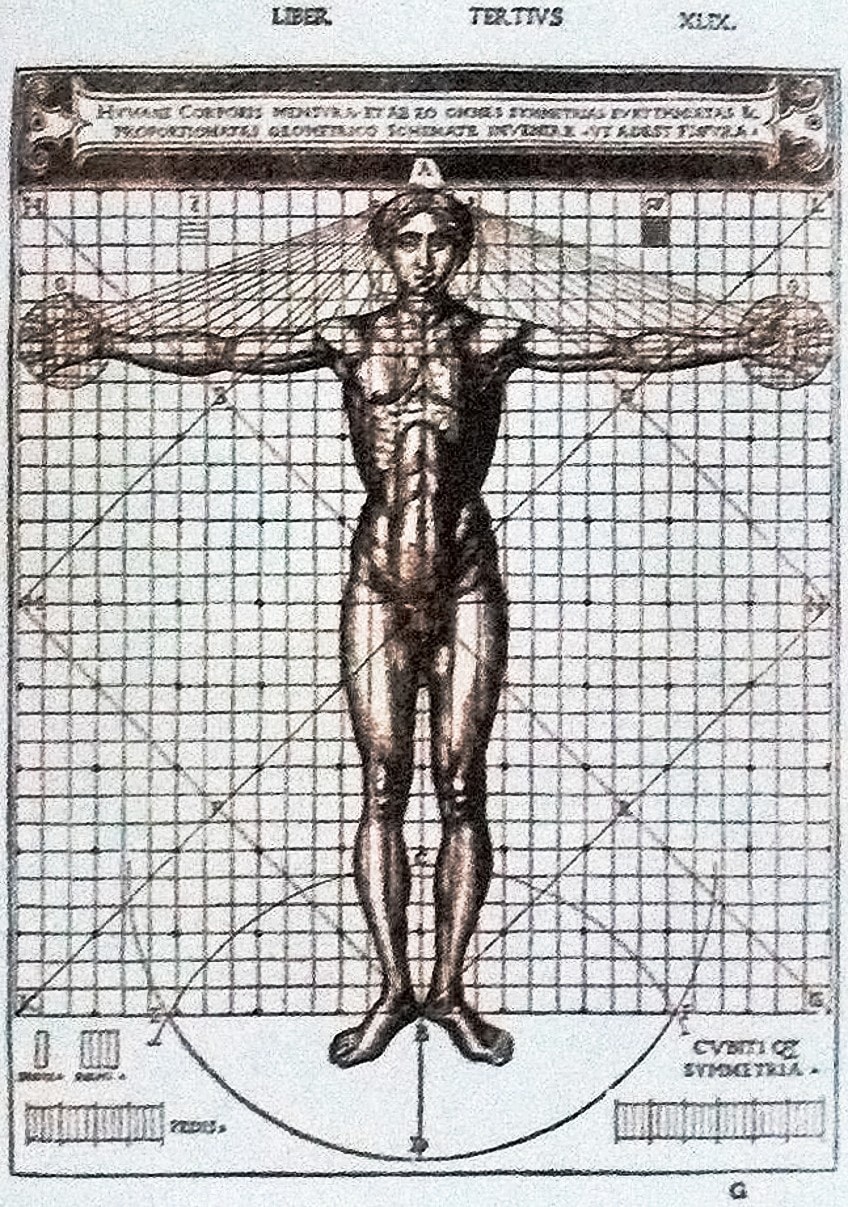
There was no idealistic or reliable method concerning the measurement of things in their relationship with living beings at the time, but this issue can be discovered a few centuries later in the evolution of the Egyptian culture, with the implementation of metrological mechanisms.
Throughout the Greek period, we can already see a consistent usage of measurement units derived from human bodily parts, illuminating Protagoras’ principle that humanity is the measure of everything.
Polykleitos, on the other hand, creates a literary canon that reportedly displays the harmonic relationship between the components as well as between them and the entirety of the human anatomy, and he would finally embody this principle in the famed Doryphoros sculpture. As a result, it is not surprising that Vitruvius outlines a strict proportional foundation for the human figure in a bold and highly specific manner.
Inspiration for the Vitruvian Physique
Although Da Vinci displays intimate familiarity with Vitruvius’ works, his drawing does not correspond to the explanation in the ancient book. He notices that the square does not have a similar middle point as a circle, but is instead centered at the crotch when sketching the square and circle.
This change is what makes Leonardo da Vinci’s artwork unique and separates it from previous drawings.
He also deviates from Vitruvius by depicting the arms lifted to the point where the fingers are even with the top of the head, as opposed to Vitruvius’ far lower angle, where the arms create lines flowing through the navel instead. Analyzing the image, one can see that the arrangement of leg and arm positions results in 16 alternative stances. The overlaid square appears to be written with the position with the arms extended out and the feet touching. The spread-eagle position, on the other hand, appears to be printed in the overlaid circle.
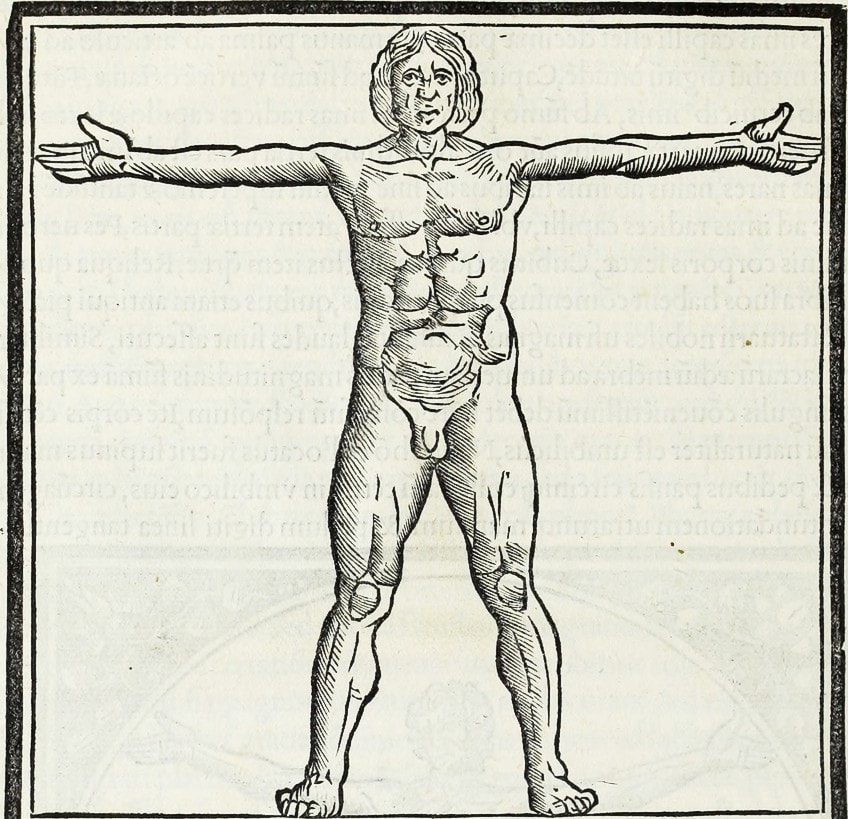
Some argue that Da Vinci included the golden ratio in Vitruvian Man due to his partnership with Luca Pacioli, although this is not confirmed by any of Da Vinci’s writings, and its measurements do not fit the golden ratio perfectly. Vitruvian Man was most likely created before he met Pacioli.
Alternatively, hypotheses for how the size of the circle was selected to better match the dimensions of the artwork include structures centered on a regular octagon.
Many painters sought to create figures that would meet Vitruvius’ assertion that a person could fit into both a square and circle, with the first known figure created in the 1480s by Francesco di Giorgio Martini. Da Vinci might have been inspired by the works of an architect and Vitruvian specialist named Giacomo Andrea, who Da Vinci dined with in 1490. He also makes a clear reference to Andrea’s Vitruvius. Andrea’s circle, like Leonardo’s Vitruvian Man, is oriented on the navel, but only one posture is shown.
The Vitruvian Man by Da Vinci is modeled on De Architectura, a construction handbook published between 30 and 15 BC by the Roman architect Vitruvius. While the book is mostly about building, it also delves into the human body, specifically the geometry of “ideal” dimensions, which piqued Da Vinci’s fascination with human anatomy and motivated his drawings. The sculpture is rarely displayed since it is too delicate to be moved around or touched. Even though it is concealed, the sketch is an essential component of the museum’s collection, and one of the most significant artworks of the Italian Renaissance.
Take a look at our Vitruvian Man webstory here!
Frequently Asked Questions
What Is The Vitruvian Man?
The Vitruvian Man was drawn by Leonardo da Vinci in one of his notebooks around 1490. The Vitruvian Man combines art and science while highlighting Da Vinci’s concern with proportion. It also exemplifies Da Vinci’s desire to draw links between nature and man. The artwork is now held in Venice, Italy, in the Gallerie dell’Accademia, but is very rarely displayed to the public for viewing.
Why Was The Vitruvian Man Created?
Leonardo da Vinci was fascinated by both science and art. While human proportion had been examined for ages, his depiction was unique owing to the changes he made according to his own studies. There are several instances of anatomical sketches that might have acted as motivation or source material. His greatest source of inspiration, however, was the works of Vitruvius, a prominent Roman architect. Da Vinci’s knowledge of mathematics and anatomy provided him with a unique capability to apply geometric ideas to his art, and The Vitruvian Man (c. 1490) is a great illustration of how he blended art and science. While Vitruvius believed the body to be a foundation of architectural proportionality, Da Vinci expanded on his discoveries and works by linking human anatomy’s uniformity to the geometry of the universe.
Jordan Anthony is a Cape Town-based film photographer, curator, and arts writer. She holds a Bachelor of Art in Fine Arts from the University of the Witwatersrand, Johannesburg, where she explored themes like healing, identity, dreams, and intuitive creation in her Contemporary art practice. Jordan has collaborated with various local art institutions, including the KZNSA Gallery in Durban, the Turbine Art Fair, and the Wits Art Museum. Her photography focuses on abstract color manipulations, portraiture, candid shots, and urban landscapes. She’s intrigued by philosophy, memory, and esotericism, drawing inspiration from Surrealism, Fluxus, and ancient civilizations, as well as childhood influences and found objects. Jordan is working for artfilemagazine since 2022 and writes blog posts about art history and photography.
Learn more about Jordan Anthony and about us.
Cite this Article
Jordan, Anthony, ““The Vitruvian Man” by Da Vinci – The Famous Vitruvian Physique.” artfilemagazine – Your Online Art Source. August 16, 2022. URL: https://artfilemagazine.com/the-vitruvian-man-by-da-vinci/
Anthony, J. (2022, 16 August). “The Vitruvian Man” by Da Vinci – The Famous Vitruvian Physique. artfilemagazine – Your Online Art Source. https://artfilemagazine.com/the-vitruvian-man-by-da-vinci/
Anthony, Jordan. ““The Vitruvian Man” by Da Vinci – The Famous Vitruvian Physique.” artfilemagazine – Your Online Art Source, August 16, 2022. https://artfilemagazine.com/the-vitruvian-man-by-da-vinci/.



